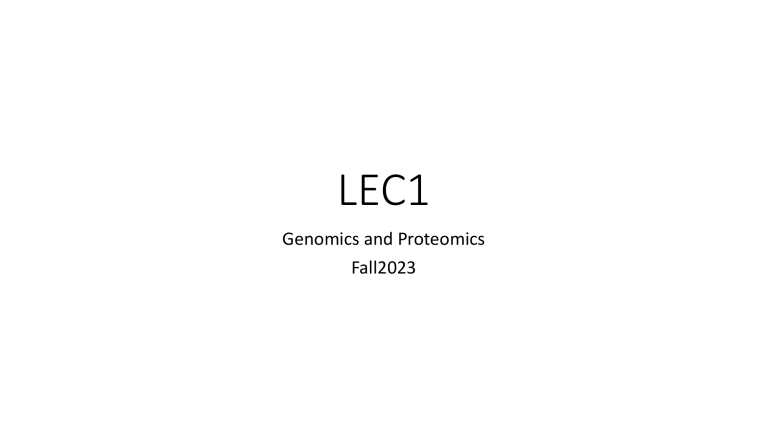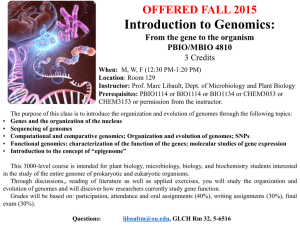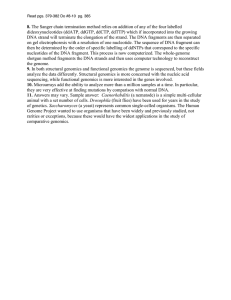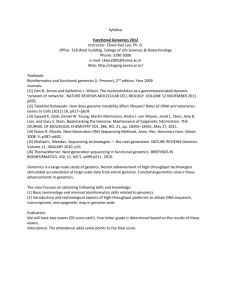
LEC1 Genomics and Proteomics Fall2023 What is the definition of genomics? Study of genomes What is the genome? Entire genetic compliment of an organism How many types of genomes are there in this world? Prokaryotic genomes Eukaryotic Genomes Nuclear Genomes Mitochondrial genomes Choloroplast genomes Why should we study genomes? • Each and everyone is a unique creation! • Lifeʼs little book of instructions • DNA blue print of life! • Human body has 1013 cells and each cell has 6 billion base pairs (A, C, G, T) • A hidden language/code determines which proteins should be made and when • This language is common to all organisms What can genome sequence tell us? • Everything about the organism's life • Its developmental program • Disease resistance or susceptibility Genomics is a discipline in genetics that applies recombinant DNA, DNA sequencing methods, and bioinformatics to sequence, assemble, and analyze the function and structure of genomes Functional genomics is a field of molecular biology that attempts to make use of the vast wealth of data produced by genomic projects (such as genome sequencing projects) to describe gene (and protein) functions and interactions. • Structural genomics seeks to describe the 3-dimensional structure of every protein encoded by a given genome. This genome-based approach allows for a high-throughput method of structure determination by a combination of experimental and modeling approaches. Epigenomics is the study of the complete set of epigenetic modifications on the genetic material of a cell, known as the epigenome. Epigenetic modifications are reversible modifications on a cell’s DNA or histones that affect gene expression without altering the DNA sequence (Russell 2010 p. 475). Two of the most characterized epigenetic modifications are DNA methylation and histone modification. Epigenetic modifications play an important role in gene expression and regulation, and are involved in numerous cellular processes such as in differentiation/development and tumorigenesis Metagenomics is the study of metagenomes, genetic material recovered directly from environmental samples. The broad field may also be referred to as environmental genomics, ecogenomics or community genomics. Origin of Genomics • Human Genome Project • Goal: sequence 3 billion base pairs • High-quality sequence (<1 error per 10 K bases) ACGT • Immensity of task required new technologies • Automated sequencing • Decision to sequence other genomes: yeast and bacteria • Beginnings of comparative genomics Functional genomics • Once we know the sequence of genes, we want to know the function • The genome is the same in all cells of an individual, except for random mutations • However, in each cell, only a subset of the genes is expressed • The portion of the genome that is used in each cell correlates with the cell’s differentiated state Analogy for gene expression • Genome is a hard drive of a computer • Contains all the programs • Gene expression • What’s loaded into RAM (short-term memory) • Subset of genome used in each cell Comparative genomics • Mechanisms of evolution • What is conserved between species? • Genes for basic processes • What makes closely related species different? • Their adaptive traits Conservation between species identifies important components • Compare parts lists • Mantle clock • Pocket watch • Wristwatch • Identify essential elements of timekeeping • Gears, hands, etc. • Superfluous parts • Wristband Identifying adaptive traits • Compare parts lists • Two watches from same maker: one with date, other without • Reveals parts likely to function in date mechanism Genomics applications to biology • Cellular function • Microarrays: RNA • Proteomics: proteins • Cellular networks: Metabolites • Evolutionary mechanisms • Comparative genomics




